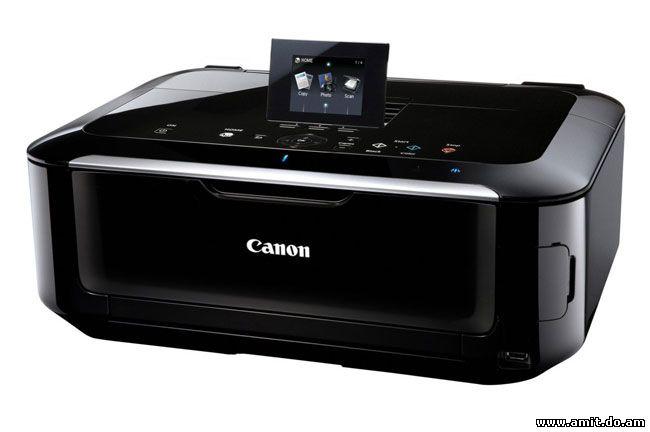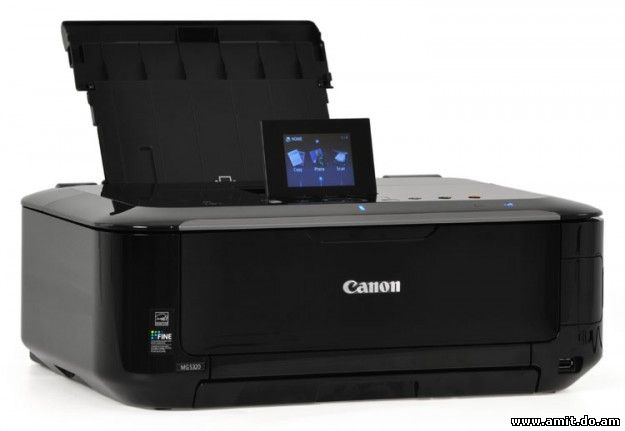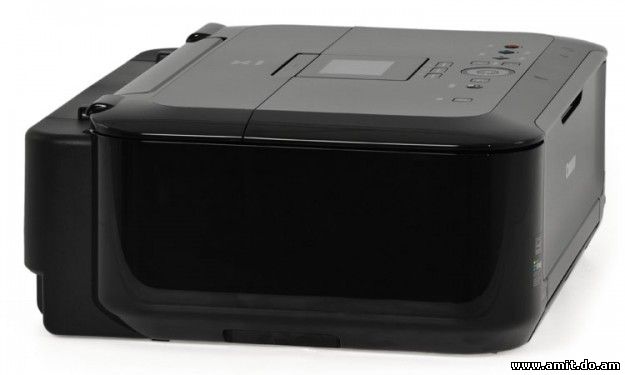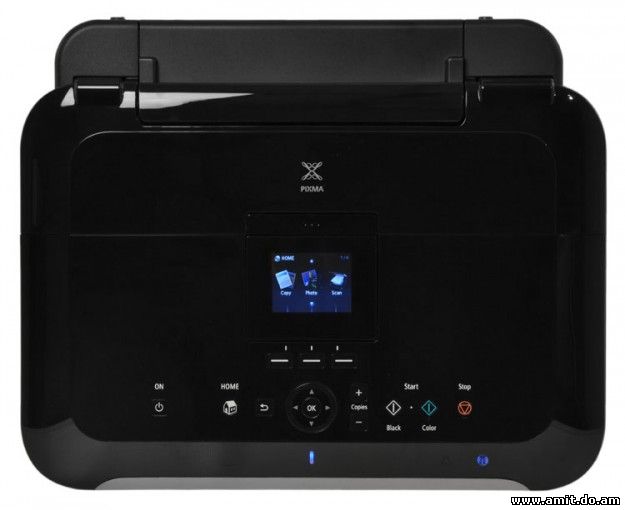A barebones printer under $100 may be the most obvious
choice when you need to lay ink to paper, but enhanced MFPs like Canon’s
new $150 MG5320 offer plenty of functionality to lure ambitious users a
little further up the price ladder. Besides the all-in-one
functionality it shares with many cheaper competitors, the MG5320 boasts
a 3.0-inch LCD and scroll wheel for navigation, built-in Wi-Fi, prints
on CDs and DVDs, autoduplexes for two-side printing without hassles, and
can print from smartphones with Canon’s free Easy-PhotoPrint app.

We found that the MG5320 largely delivers on these features, but
users should be willing to put up with some glitches and minor
frustrations (think reconnecting to the Wi-Fi network or waiting for
processing to finish). That said, it’s affordability and print quality,
not to mention ease-of-use, make up for these shortcomings.
Build and design
The MG5320 wins points for its lack of angles. The printer is capable
of folding down into a completely flat-sided box: Both trays and the
pop-up display can be pushed in, and you don’t have to remember to open
that tray when printing either. It will automatically unfold itself if
you forget to do so. It’s a generally sleek-looking printer, with the
exception of the massive amount of finger prints it picks up.

The printer’s controls are located entirely on top of the machine,
and a small 3-inch LCD. That 3-inch specification is sort of stretching
the truth, seeing that there’s a fairly thick black border around the
screen, giving you less viewing room. This means it’s a little under a
2.5-inch screen. We didn’t find this terribly inhibiting, because of the
control scheme. Users scroll through the Pixma’s main options as
screen-filling pages, instead of viewing them simultaneously laid out in
a main menu. This may sound slightly disorienting (it’s different than
how most electronic home screens look!) but it’s not, and it means the
icons are big, bold, bright, and captioned.
The
display’s in-screen functions mean the Pixma’s physical surfaces are
relatively empty. There’s a power button, controls for home, B&W and
color printing, a control to cancel printing, a back button, and a dial
with OK to select in the middle. Above this are three "function”
controls, which are used to select options presented on the LCD display.
Oddly, photo printing pulls from the Pixma’s rear tray. We were
primarily printing 4×6 photos, and the giant tray looked somewhat
ridiculous for that size. Obviously, this isn’t a caveat or really a
problem at all, just non-traditional if anything. There’s a sliding
paper guide to hold the sheet size of your choice in place. The paper
tray can be found below, and documents feed into the fold-out tray on
the very front of the Pixma.
Setup and use
There isn’t much to setup here. After heaving the printer out of its
box (which is never a small feat, but the Pixma’s rectangular shape
helps) and installing the ink cartridges, it’s all a matter of walking
through menus. The power button will pull up the home screen, and you’ll
need to decide whether you want to hook the Pixma up via USB or Wi-Fi.
Now here’s where the button placement can get a little confusing. A
typical scenario: Scroll using the arrows on the physical dial until you
find Setup. It’s off to the right, so you’ll want to press the right
arrow – but that won’t do anything. Instead, you’re supposed to press
the function button below the icon. This is not a big deal, but if
you’ve used dials like this on digital cameras or video game
controllers, it’s a little disorienting at first and takes awhile to get
used to. We continually found ourselves pressing the dial’s arrows and
wondering why nothing was happening. Luckily, Canon gives you a gentle
reminder to look for the "function” buttons directly below the in-screen
icons.

If you choose to use Wi-Fi printing, you’ll need to find the right
network and then go through the somewhat-painful process of entering the
password. There’s obviously not a keyboard, so you have to find the
correct characters one at a time.
The pop-up screen is a clever solution, and one we enjoyed using. It
has an almost plastic-toy feel to it, which some might equate with
cheap, but it didn’t feel breakable to us. There are four "home” screens
you scroll through, and the home and back buttons do a good job of
keeping you from getting lost.
Innovative features
For its modest $150 price, the Pixma really does manage to live up to
the title of multifunction printer. In addition to photo and document
printing, Wi-Fi, scanning, it also includes CD and DVD printing
capabilities. Unfortunately, it’s not exactly a simple process. You
manual insert the included platform, and the in-screen navigation
doesn’t include the most detailed instructions for this process. The
manual software does the best job of assisting you here, but it’s not
tremendously quick or easy.

Of course, it’s a function that most MFPs don’t include to begin
with, and we can’t imagine it’s used all that often. It’s worth noting
that the platform that you insert to print on CDs and DVDs can’t be
stored anywhere on the printer itself, so it’s a loose object you have
to take care not to lose.
We
liked the quick connection between the PC and the printer. When
scanning or sending a scanned document or photo to the PC, our computer
screen registered the activity almost instantly, basically giving us a
little sign it was hearing the printer and working on it. The microSD
slot is conveniently tucked into the side of the printer as well, with a
discreet door. Too often, electronics have their ports around the back
or near the bottom edge, and with a device you don’t want to move around
– like a printer – putting this feature front and center is helpful. A
USB port for thumb drives is directly below.
The Pixma boasts a 150-sheet paper tray, as well as its rear tray for
other materials (photo paper, etc). The output tray holds up to 50
sheets – but our favorite feature was how it automatically popped open
when we started a print job.
Canon’s mobile Easy-PhotoPrint app (for both iOS and Android)
connected to the Pixma just fine. It lets you set up a printing queue
with different details (photo paper type, size, borders) for each
individual image. Transferring the print job from the phone to the
printer was just as quick as printing from a PC.
One other included feature that doesn’t get a lot of attention, but
that’s definitely worth noting, is the Pixma’s auto-duplexing. It means
the printer automatically prints on both sides of the paper instead of
forcing you to manually reinsert pages to print on the backs. This isn’t
a huge hassle, but it keeps you from wasting paper (and money) without
thinking about it.

Print performance
We started out by testing the Pixma’s photo printing abilities, and
were impressed. It’s quite fast, and quality was good, even more so
using Canon’s own photo paper. We tested with stock photo paper and the
photos looked grainier. However, even extremely dark pictures were nice
and black where they should be, no gray tones.
Printing a full page proved difficult. We initially attempted to
print a very detailed image as an 8×10, then as a 4×6, and the MG5320
quit about halfway through each time, with no warning of an ink shortage
or error message. We had a different glitch with document printing as
well: We attempted to print a full page of directions, sending it from
the PC to the printer. This happened more than once, and the Pixma would
start recognizing the print job, only to suddenly return to the home
screen. The computer would show it was still attempting to print,
however, and we were stuck waiting to see if the printer would
acknowledge the request. After reconnecting the printer to the Wi-Fi
network, it started working. Strangely, we never experienced this glitch
with photo printing.

Once we were able to print, text was crisp and black and fairly
quick. In one test, we printed three, rich full-text documents in about
one minute, and three high-quality 4×6 photos in about two minutes.
Nothing very remarkable as far as speed – although the "fast” setting
was quicker and didn’t appear to sacrifice much quality. Canon’s stated
speeds are 12.5 images per minute in black, with color trailing slightly
behind at 9.3 images per minute, and 20 seconds for 4×6 photo prints.
We printed, scanned, and then reprinted a few photos and text
documents as well – a test of both the scanner’s accuracy and how well
the printer can reproduce images. While quality naturally went down with
each reprint, our photos were still rich and print was still easy to
read. One of the best features about the machine is how quiet it is as
well. Everything is a fairly silent process, which a "quiet” setting
(easily found from the home screen) improves even more. The only
exception is the brief "processing” stage as the MG5320 prepares to
print and makes a few clicking noises.
Something that’s incredibly important to consider before buying a
printer is its ink costs. And the Pixma’s are pretty fair: A black
cartridge is $16, and cyan, magenta, and yellow cartridges are $14
apiece. They last for 339 and between 486 and 530 pages, respectively.
It’s not the least expensive ink pricing out there, but it’s pretty
reasonable for small-volume printers.
Conclusion
Honestly, we’re so taken with Wi-Fi printers that choosing one
without wireless functionality in 2011 is somewhat difficult to justify.
We were happy with how easily the Pixma MG5320 connected to our
computer, and the provided Canon software was actually quite helpful for
printing and formatting photos.
Unfortunately, the printing glitches were extremely frustrating.
Struggling with your printing is never fun, but it’s almost more
maddening when you can see via the pop-up screen that your requests are
being ignored. That said, simple restarts generally worked as a fix, and
we don’t want to dismiss an otherwise capable printer if these results
weren’t typical. Glitches aside, the Pixma MG5320 was easy to setup and
navigate, printed high-quality photos, zipped out pages quickly, and
barely made a peep compared to some noisy competitors. At $150, it
brings a lot to the table if you’re willing to make a few sacrifices
working through its kinks.
Highs:
- Printing is extremely quiet
- Slick, compact design
- Packs a punch for its price and size
Lows:
- Glitchy out of the box
- Initially disorienting button placement